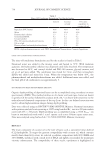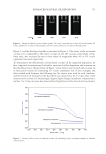717 PHYSICOCHEMICAL PROPERTIES OF TEXTURED HAIR For comparison, Figure 5 presents a FESEM micrograph of tightly curled African hair. Again, this hair type has a CI value of 0.63 ± 0.13. In this particular fiber, less cuticular damage and a decreased degree of ellipticity are observed. Although we postulate that higher degrees of curliness and ellipticity could in part be responsible for the fiber’s susceptibility to grooming damage, the history of the fiber is certainly a major factor in determining the extent of damage. Nevertheless, tightly curled African hair shares common features with Figure 3. FESEM micrograph of extremely tightly curled African hair demonstrating its characteristic features and highly elliptical structure. Note that the root end direction of the fiber is on the right side of the image. Figure 4. FESEM micrograph of extremely tightly curled African hair at one of its points of curvature. Note that the root end direction of the fiber is on the left side of the image.
718 JOURNAL OF COSMETIC SCIENCE extremely tightly curled African hair, however, to a lesser extent. For example, it still has a more elliptical structure than Caucasian hair and contains a certain degree of concavity along the hair axis on the large face of the fiber. When we examine the curvature point in tightly curled African hair, we find similar behavior to that observed in extremely tightly curled African hair, as shown in Figure 6. In this case, the overall geometry appears slightly different at the curvature point, although Figure 5. FESEM micrograph of tightly curled African hair. Note that the root end direction of the fiber is on the right side of the image. Figure 6. FESEM micrograph of tightly curled African hair at one of its points of curvature. Note that the root end direction of the fiber is at the top of the image.
Purchased for the exclusive use of nofirst nolast (unknown) From: SCC Media Library & Resource Center (library.scconline.org)






































































































































